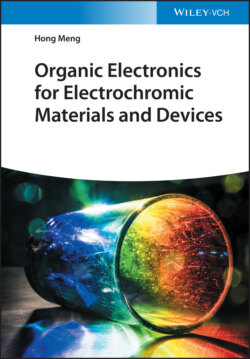Читать книгу Organic Electronics for Electrochromic Materials and Devices - Hong Meng - Страница 27
2.3.1.3 PVDF‐Based Polymer Electrolytes
ОглавлениеPVDF is another popular host material for electrolytes and has recently been widely used in ECDs. PVDF offers many advantages, such as good thermomechanical properties, fairly high permittivity, high hydrophobicity, thermal and chemical stabilities, and chemical resistance. As a semi‐crystalline polymer, the PVDF crystalline phase provides thermal stability, while the amorphous phase provides the flexibility required for ECDs. PVDF can be soluble in high boiling point and commercial solvents, such as N‐methyl‐2‐pyrrolidone (NMP) and dimethylformamide (DMF). However, comparing with lithium salt, PVDF, which is expected to have a low donor number (DN), is insoluble and cannot be used effectively in polymer salt complexes. For EC application, PVDF‐based PEs have been identified as interesting candidates and their study is in progress. As was reported by Fabrettos group, an ECD was prepared by using PVDF for studying the coloration efficiency [53]. P(VDF‐TrFE) as GPE was also studied as potential PE in ECD with polyaniline as EC materials [1]. The gel electrolyte device reached an average ionic conductivity of 2.84 × 10−5 S/cm and shows stable and reversible light modulation up to 65% in gel state. It was found that the gel‐state device was affected by the number of free ions, while the movement of ions in the electrolyte bulk and the modulation of light in the semisolid device are indicated by the electrolyte/EC material interface.
The ionic conductivity of PVDF PEs can be enhanced by incorporating substantial amounts of plasticizers or combining with IL. Jia et al. have studied 1‐butyl‐3‐methylimidazolium hexafluorophosphate‐loaded SCCO2‐treated electrospun P(VDF‐HFP) membrane as an electrolyte in EC device [54].
Recently, Reynold's group reported paper‐based ECDs consisting of PEDOT:PSS electrodes and [EMI][TFSI]/PVDF‐HFP ion gel electrolyte layer (Figures 2.2 and 2.3) [55]. The ECDs incorporating an ion gel electrolyte were demonstrated where a magenta‐to‐colorless device achieves a color contrast (ΔE*) of 56, attributing to a highly color‐neutral bleached state of the extracellular protein (ECP) (a* = −0.5, b* = 2.9). It was found that the gel‐state device was affected by the number of free ions, while the movement of ions in the electrolyte bulk and the modulation of light in the semisolid device were indicated by the electrolyte/EC material interface.
Figure 2.2 Schematic showing printing of colored‐to‐clear electrochromic paper incorporating cellulose nanofiber (CNF)‐coated paper substrates and PEDOT:PSS electrodes as well as the repeat‐unit structures of (a) ECP‐Cyan, (b) ECP‐Magenta, (c) ECP‐Yellow, and (d) ECP‐Black. R = ethylhexyl.
Source: Lang et al. [55].
Figure 2.3 A fabrication process for lateral paper ECDs showing inkjet‐printed PEDOT:PSS electrodes, deposition of ECPs, and [EMI][TFSI]/PVDF‐HFP ion gel electrolyte layer. Devices are operated by applying a 0.8 V bias across the two lateral pixels.
Source: Lang et al. [55].
